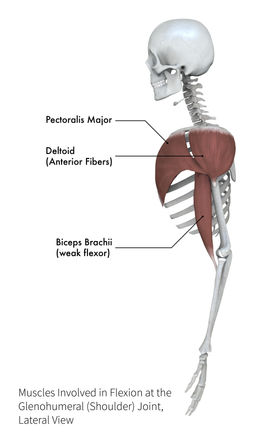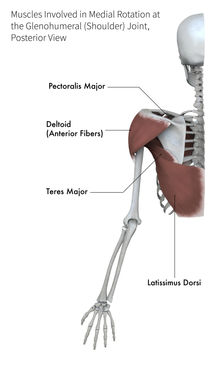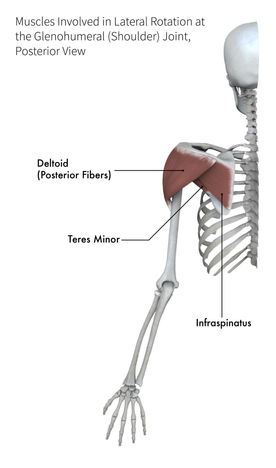

The Glenohumeral (Shoulder) Joint
The glenohumeral (shoulder) joint is a ball and socket joint formed by articulation between the head of the humerus and glenoid fossa of the scapula.
It is one of the most mobile joints in the human body, permitting many movements, including flexion, extension, abduction, adduction, medial rotation, lateral rotation and circumduction.
Flexion can be described as bringing the upper limb forwards in the sagittal plane. This motion is demonstrated in the accompanying animated model. The usual range of motion is 180 degrees.
The muscles that act to produce flexion of the shoulder are the deltoid (anterior fibers), pectoralis major (clavicular head) and coracobrachialis. The biceps brachii muscle is also a weak flexor of the shoulder.
Flexion
Extension
Extension can be described as bringing the upper limb backwards in a sagittal plane. This motion is demonstrated in the accompanying animated model. The full movement demonstrated is extension, but the term hyperextension is often used to describe the movement that occurs posteriorly to the anatomical position.
The muscles that act to produce extension of the shoulder are the deltoid (posterior fibers), latissimus dorsi, teres major, triceps brachii and pectoralis major (sternocostal head). The pectoralis major muscle does not contribute to extension beyond the anatomical position.
Abduction
Abduction can be described as bringing the upper limb away from the midline in the coronal plane. This motion is demonstrated in the in the accompanying animated model. The normal range of motion is 150 degrees.
The supraspinatus is responsible for the first 0 to 15 degrees of abduction. The deltoid (middle fibers) is responsible for the next 15 to 90 degrees of abduction. The serratus anterior and trapezius cause the scapula to rotate and allow for abduction beyond 90 degrees.
Adduction
Adduction can be described as bringing the upper limb towards the midline in the coronal plane. This motion is demonstrated in the accompanying animated model.
The muscles that act to produce adduction of the shoulder are pectoralis major, latissimus dorsi, teres major and coracobrachialis.
Lateral Rotation
Medial Rotation
Medial Rotation
Medial rotation can be described as rotation toward the midline along a vertical axis. This motion is demonstrated in the accompanying animated model.
The muscles that act to produce medial rotation at the shoulder joint are pectoralis major, deltoid (anterior fibers), latissimus dorsi, teres major and subscapularis.
Lateral Rotation
Lateral rotation can be described as rotation away from the midline along a vertical axis. This motion is demonstrated in the accompanying animated model.
The muscles that act to produce lateral rotation at the shoulder joint are teres minor, deltoid (posterior fibers) and infraspinatus.
Circumduction
Circumduction is a combination of all the individual movements possible at the shoulder joint. As a result, many of the muscles already listed on this page act in a co-ordinated manner to produce circumduction.
_edited_j.jpg)















